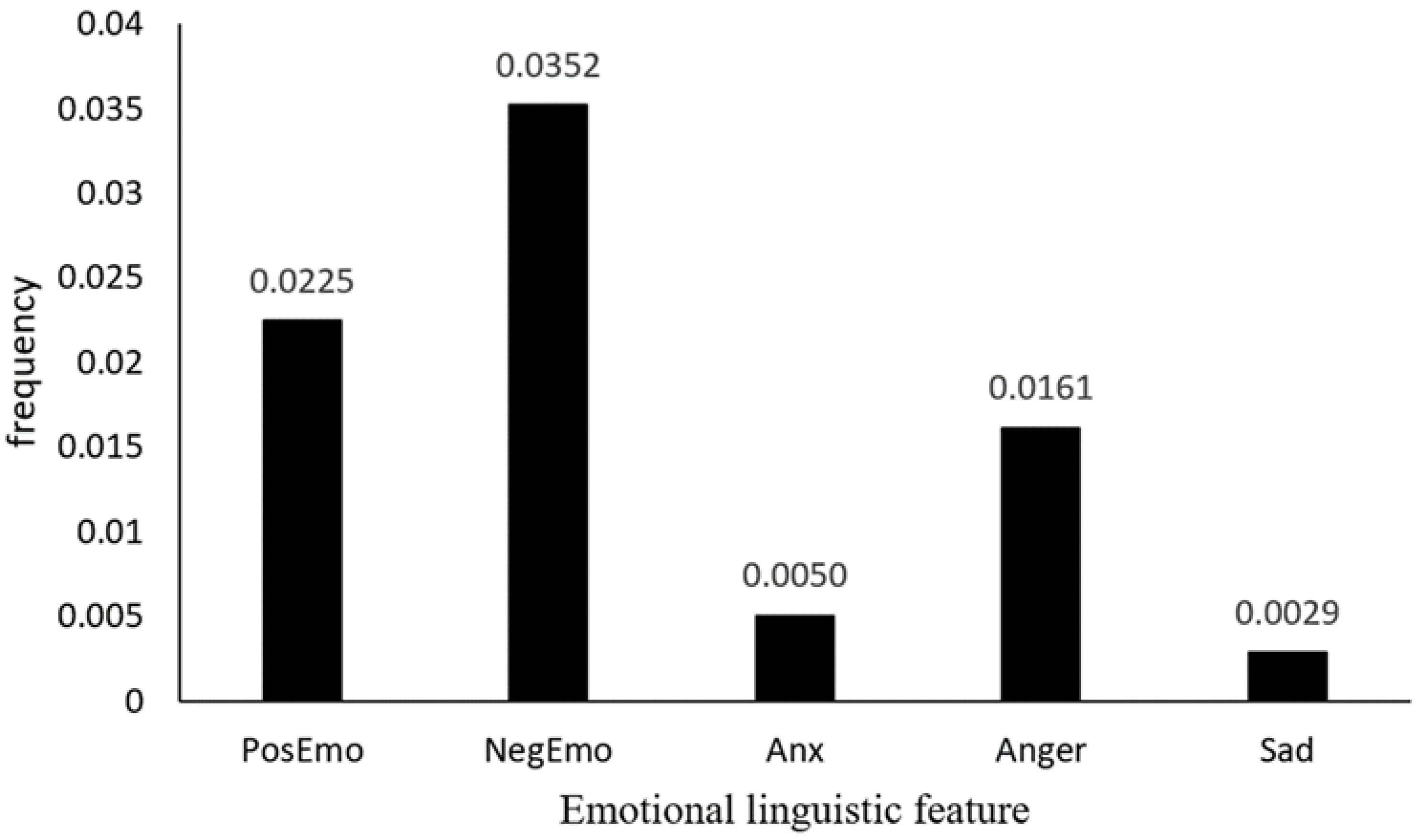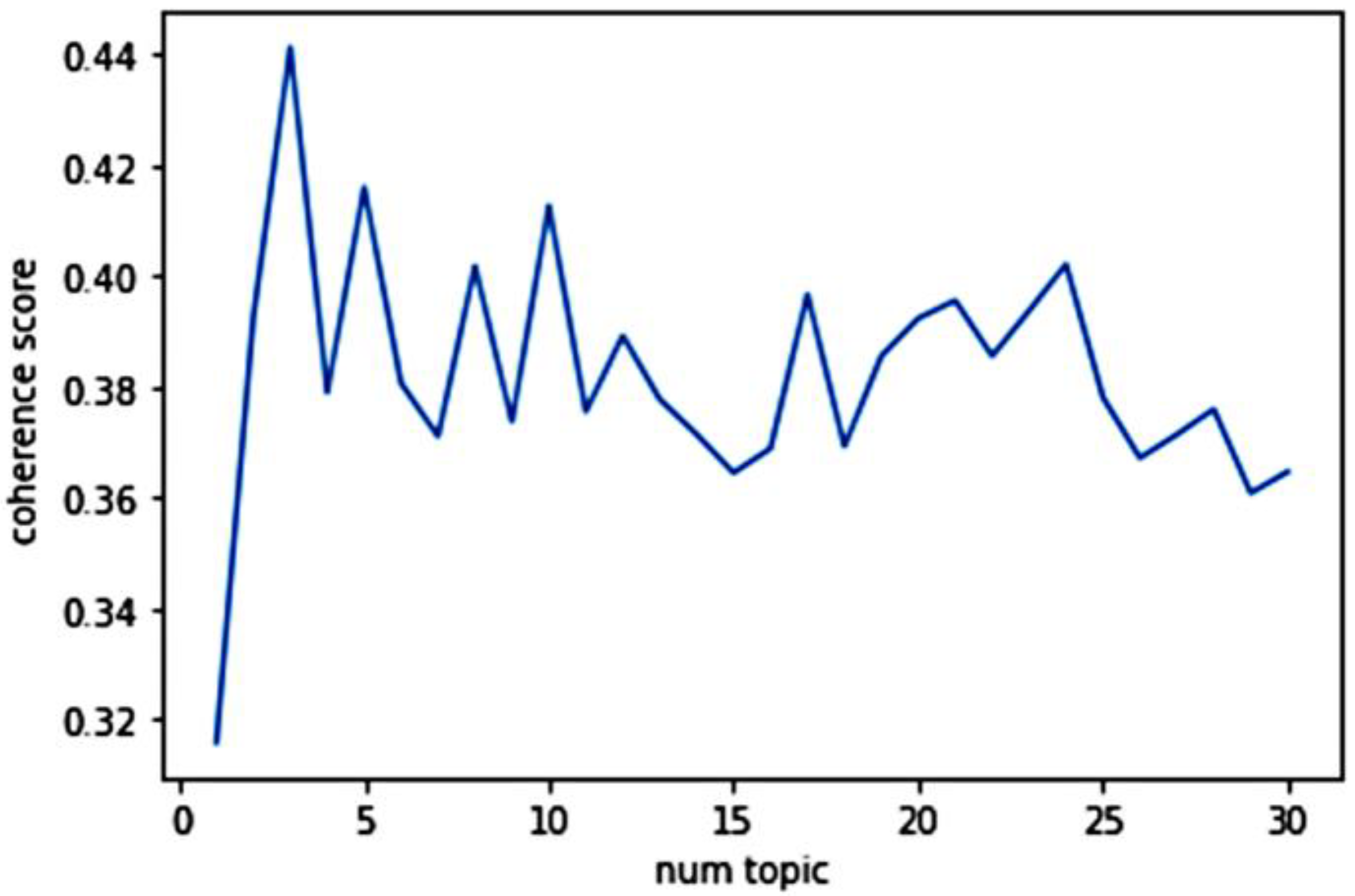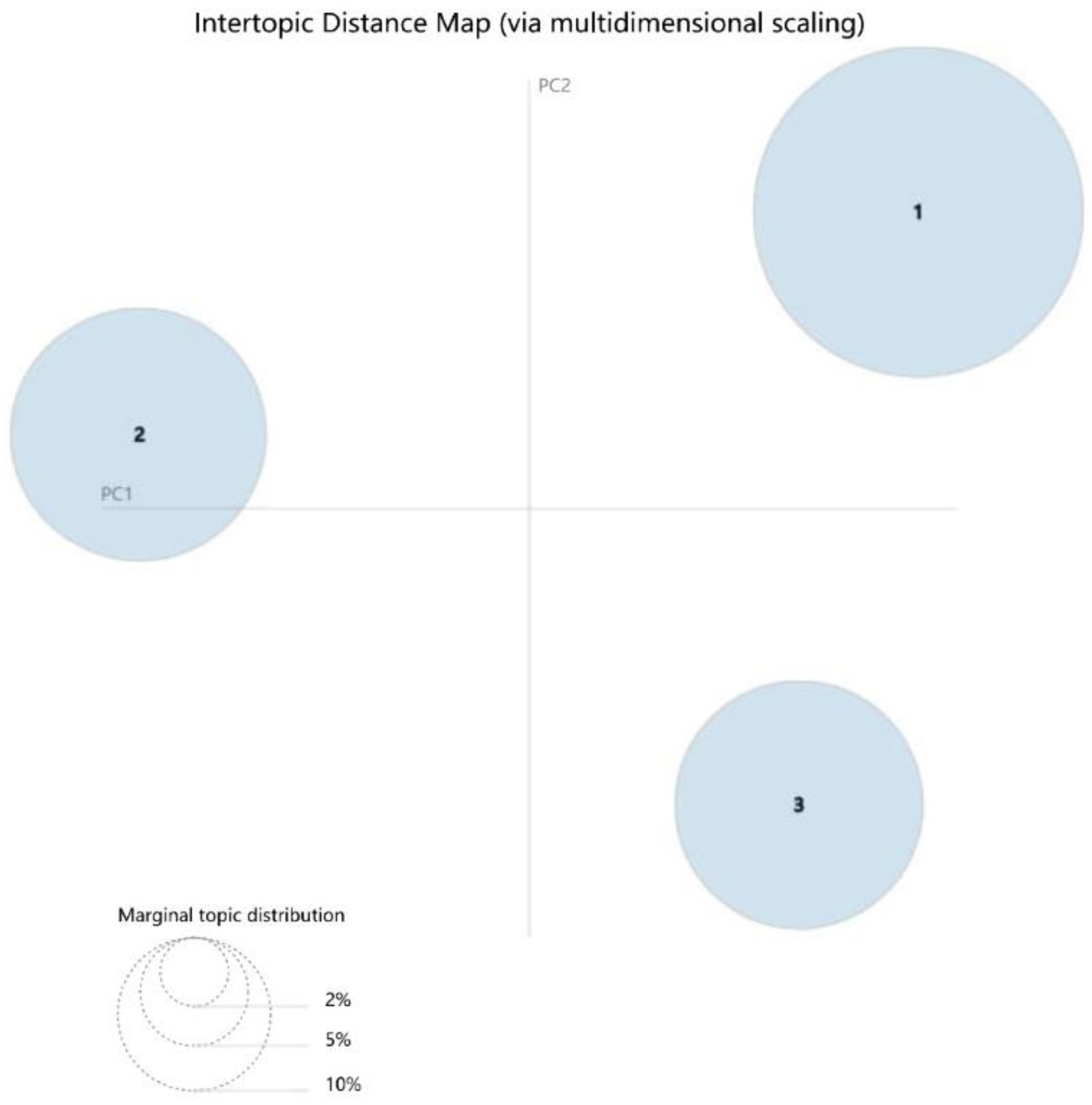How Do Chinese People View Cyberbullying? A Text Analysis Based on Social Media
Abstract
:1. Introduction
1.1. Attitude towards Cyberbullying
1.2. Exploring Attitude with Natural Language Processing (NLP) Techniques
1.3. The Current Study
2. Materials and Methods
2.1. Data Collection
2.2. Data Processing
2.3. Data Analysis
3. Results
3.1. Sentiment Analysis
3.2. Cyberbullying Related Topics
4. Discussion
4.1. Emotional Aspect of Attitude towards Cyberbullying
4.2. Cognitive Aspect of Attitude towards Cyberbullying
4.3. Implications, Limitations, and Future Direction
5. Conclusions
Author Contributions
Funding
Institutional Review Board Statement
Informed Consent Statement
Data Availability Statement
Conflicts of Interest
References
- Tokunaga, R.S. Following you home from school: A critical review and synthesis of research on cyberbullying victimization. Comput. Hum. Behav. 2010, 26, 277–287. [Google Scholar] [CrossRef]
- Campbell, M.; Bauman, S. (Eds.) Cyberbullying: Definition, consequences, prevalence. In Reducing Cyberbullying in Schools: International Evidence-Based Best Practices; Elsevier: London, UK, 2018; pp. 3–16. ISBN 978-0-12-811423-0. [Google Scholar]
- Zhu, C.; Huang, S.; Evans, R.; Zhang, W. Cyberbullying among adolescents and children: A comprehensive review of the global situation, risk factors, and preventive measures. Front. Public Health 2021, 9, 634909. [Google Scholar] [CrossRef] [PubMed]
- Wang, M.-J.; Yogeeswaran, K.; Andrews, N.P.; Hawi, D.R.; Sibley, C.G. How common is cyberbullying among adults? Exploring gender, ethnic, and age differences in the prevalence of cyberbullying. Cyberpsychol. Behav. Soc. Netw. 2019, 22, 736–741. [Google Scholar] [CrossRef] [PubMed] [Green Version]
- Huang, J.; Zhong, Z.; Zhang, H.; Li, L. Cyberbullying in social media and online games among Chinese college students and its associated factors. Int. J. Environ. Res. Public Health 2021, 18, 4819. [Google Scholar] [CrossRef] [PubMed]
- Giménez Gualdo, A.M.; Hunter, S.C.; Durkin, K.; Arnaiz, P.; Maquilón, J.J. The emotional impact of cyberbullying: Differences in perceptions and experiences as a function of role. Comput. Educ. 2015, 82, 228–235. [Google Scholar] [CrossRef] [Green Version]
- Tong, D.; Talwar, V. Students’ moral emotions and judgments of cyberbullying: The influence of previous cyberbullying experiences. Curr. Psychol. 2020; Advance online publication. [Google Scholar] [CrossRef]
- Ranney, M.L.; Pittman, S.K.; Riese, A.; Koehler, C.; Ybarra, M.; Cunningham, R.; Spirito, A.; Rosen, R.K. What counts?: A qualitative study of adolescents’ lived experience with online victimization and cyberbullying. Acad. Pediatr. 2020, 20, 485–492. [Google Scholar] [CrossRef]
- Barlett, C.P.; Gentile, D.A. Attacking others online: The formation of cyberbullying in late adolescence. Psychol. Pop. Media Cult. 2012, 1, 123–135. [Google Scholar] [CrossRef] [Green Version]
- Doane, A.N.; Kelley, M.L.; Pearson, M.R. Reducing cyberbullying: A theory of reasoned action-based video prevention program for college students. Aggress. Behav. 2016, 42, 136–146. [Google Scholar] [CrossRef]
- Heirman, W.; Walrave, M. Predicting adolescent perpetration in cyberbullying: An application of the theory of planned behavior. Psicothema 2012, 24, 614–620. [Google Scholar]
- Barlett, C.P.; Seyfert, L.W.; Simmers, M.M.; Chen, V.H.H.; Cavalcanti, J.G.; Krahé, B.; Suzuki, K.; Warburton, W.A.; Wong, R.Y.M.; Pimentel, C.E.; et al. Cross-cultural similarities and differences in the theoretical predictors of cyberbullying perpetration: Results from a seven-country study. Aggress. Behav. 2021, 47, 111–119. [Google Scholar] [CrossRef]
- Munnelly, A.; Farrell, L.; O’Connor, M.; McHugh, L. Adolescents’ implicit and explicit attitudes toward cyberbullying: An exploratory study using the Implicit Relational Assessment Procedure (IRAP) and self-report measures. Psychol. Rec. 2018, 68, 1–10. [Google Scholar] [CrossRef]
- Yang, D.J.; Lu, S.; Chen, S.C.; Shu, H. Does the attitude of adolescents on anti-cyberbullying affect their behavior? In Proceedings of the 2019 3rd International Seminar on Education, Management and Social Sciences, Changsha, China, 19–21 July 2019; Atlantis Press: Changsha, China, 2019. [Google Scholar]
- Van Aalderen-Smeets, S.I.; Walma van der Molen, J.H.; Asma, L.J.F. Primary teachers’ attitudes toward science: A new theoretical framework. Sci. Educ. 2012, 96, 158–182. [Google Scholar] [CrossRef]
- Verplanken, B.; Hofstee, G.; Janssen, H.J.W. Accessibility of affective versus cognitive components of attitudes. Eur. J. Soc. Psychol. 1998, 28, 23–35. [Google Scholar] [CrossRef]
- Shanahan, J.G.; Qu, Y.; Wiebe, J. (Eds.) Computing Attitude and Affect in Text: Theory and Applications; Springer: Dordrecht, The Netherlands, 2006. [Google Scholar]
- Orsolini, L.; Papanti, G.D.; Francesconi, G.; Schifano, F. Mind navigators of chemicals’ experimenters? A web-based description of e-psychonauts. Cyberpsychol. Behav. Soc. Netw. 2015, 18, 296–300. [Google Scholar] [CrossRef] [PubMed]
- Orsolini, L.; Francesconi, G.; Papanti, D.; Giorgetti, A.; Schifano, F. Profiling online recreational/prescription drugs’ customers and overview of drug vending virtual marketplaces. Hum. Psychopharmacol.-Clin. Exp. 2015, 30, 302–318. [Google Scholar] [CrossRef] [PubMed] [Green Version]
- Calvo, R.A.; Milne, D.N.; Hussain, M.S.; Christensen, H. Natural language processing in mental health applications using non-clinical texts. Nat. Lang. Eng. 2017, 23, 649–685. [Google Scholar] [CrossRef] [Green Version]
- O’Dea, B.; Wan, S.; Batterham, P.J.; Calear, A.L.; Paris, C.; Christensen, H. Detecting suicidality on Twitter. Internet Interv. 2015, 2, 183–188. [Google Scholar] [CrossRef] [Green Version]
- Hussain, A.; Tahir, A.; Hussain, Z.; Sheikh, Z.; Gogate, M.; Dashtipour, K.; Ali, A.; Sheikh, A. Artificial intelligence–enabled analysis of public attitudes on Facebook and Twitter toward COVID-19 vaccines in the United Kingdom and the United States: Observational study. J. Med. Internet Res. 2021, 23, e26627. [Google Scholar] [CrossRef]
- Wang, Y.; Dai, Y.; Li, H.; Song, L. Social media and attitude change: Information booming promote or resist persuasion? Front. Psychol. 2021, 12, 596071. [Google Scholar] [CrossRef]
- Yu, L.; Jiang, W.; Ren, Z.; Xu, S.; Zhang, L.; Hu, X. Detecting changes in attitudes toward depression on chinese social media: A text analysis. J. Affect. Disord. 2021, 280, 354–363. [Google Scholar] [CrossRef]
- Mäntylä, M.V.; Graziotin, D.; Kuutila, M. The evolution of sentiment analysis—A review of research topics, venues, and top cited papers. Comput. Sci. Rev. 2018, 27, 16–32. [Google Scholar] [CrossRef] [Green Version]
- Shaver, P.; Schwartz, J.; Kirson, D.; O’Connor, C. Emotion knowledge: Further exploration of a prototype approach. J. Pers. Soc. Psychol. 1987, 52, 1061–1086. [Google Scholar] [CrossRef] [PubMed]
- Izard, C.E. Basic emotions, relations among emotions, and emotion-cognition relations. Psychol. Rev. 1992, 99, 561–565. [Google Scholar] [CrossRef] [PubMed]
- Tausczik, Y.R.; Pennebaker, J.W. The psychological meaning of words: LIWC and computerized text analysis methods. J. Lang. Soc. Psychol. 2010, 29, 24–54. [Google Scholar] [CrossRef]
- Zhao, N.; Jiao, D.; Bai, S.; Zhu, T. Evaluating the validity of simplified Chinese version of LIWC in detecting psychological expressions in short texts on social network services. PLoS ONE 2016, 11, e0157947. [Google Scholar] [CrossRef] [Green Version]
- Lee, Y.S. Measures of student attitudes on aging. Educ. Gerontol. 2009, 35, 121–134. [Google Scholar] [CrossRef]
- McDonnell, M.; Owen, J.E.; Bantum, E.O. Identification of emotional expression with cancer survivors: Validation of Linguistic Inquiry and Word Count. JMIR Form. Res. 2020, 4, e18246. [Google Scholar] [CrossRef]
- McHugh, M.C.; Saperstein, S.L.; Gold, R.S. OMG U #Cyberbully! An exploration of public discourse about cyberbullying on Twitter. Health Educ. Behav. 2019, 46, 97–105. [Google Scholar] [CrossRef]
- Watson, D.; Clark, L.A.; Tellegen, A. Development and validation of brief measures of positive and negative affect: The PANAS scales. J. Pers. Soc. Psychol. 1988, 54, 1063–1070. [Google Scholar] [CrossRef]
- Hu, T.-Y.; Xie, X.; Li, J. Negative or positive? The effect of emotion and mood on risky driving. Transp. Res. Part F-Traffic Psychol. Behav. 2013, 16, 29–40. [Google Scholar] [CrossRef]
- Abdo, M.S.; Alghonaim, A.S.; Essam, B.A. Public perception of COVID-19’s global health crisis on Twitter until 14 weeks after the outbreak. Digit. Scholarsh. Humanit. 2021, 36, 509–524. [Google Scholar] [CrossRef]
- Piepenbrink, A.; Gaur, A.S. Topic models as a novel approach to identify themes in content analysis. In Academy of Management Proceedings; Taneja, T., Ed.; Academy of Management: New York, NY, USA, 2017; Volume 2017. [Google Scholar]
- Blei, D.M.; Ng, A.Y.; Jordan, M.I. Latent dirichlet allocation. J. Mac. Learn. Res. 2003, 3, 993–1022. [Google Scholar]
- O’Neill, B.; Dinh, T. Mobile technologies and the incidence of cyberbullying in seven European countries: Findings from net children go mobile. Societies 2015, 5, 384–398. [Google Scholar] [CrossRef] [Green Version]
- Tahamtan, I.; Huang, L.-M. #Cyberbullying in the digital age: Exploring people’s opinions with text mining. Proc. Assoc. Inf. Sci. Technol. 2019, 56, 672–673. [Google Scholar] [CrossRef]
- Hu, Q.; Bernardo, A.B.I.; Lam, S.W.; Cheang, P.K. Individualism-Collectivism orientations and coping styles of cyberbullying victims in Chinese culture. Curr. Psychol. 2018, 37, 65–72. [Google Scholar] [CrossRef]
- Available online: https://github.com/SeleniumHQ/selenium/tree/trunk/py (accessed on 27 January 2022).
- Available online: https://github.com/fxsjy/jieba (accessed on 27 January 2022).
- Available online: https://github.com/goto456/stopwords (accessed on 27 January 2022).
- Wicke, P.; Bolognesi, M.M. Framing COVID-19: How we conceptualize and discuss the pandemic on Twitter. PLoS ONE 2020, 15, e0240010. [Google Scholar] [CrossRef]
- Gao, R. Technology of Microblog Content Psychological Analysis Research and Application. Master’s Thesis, University of Chinese Academy of Sciences, Beijing, China, 2014. (In Chinese). [Google Scholar]
- Gao, R.; Hao, B.; Li, H.; Gao, Y.; Zhu, T. Developing simplified Chinese psychological linguistic analysis dictionary for microblog. In Proceedings of the 2013 International Conference on Brain and Health Informatics, Maebashi, Japan, 29–31 October 2013; Springer: Cham, Switzerland, 2013; pp. 359–368. [Google Scholar]
- Pennebaker, J.W.; Chung, C.K.; Ireland, M.; Gonzales, A.; Booth, R.J. The Development and Psychometric Properties of LIWC2007; LIWC.net: Austin, TX, USA, 2001. [Google Scholar]
- Wu, X.; Wu, H.; Xie, X.; Xu, J.; Zhang, T. Short text topic recognition and optimization method for university online community. In Proceedings of the International Conference on Artificial Intelligence and Security 2019, New York, NY, USA, 26–28 July 2019; Sun, X., Pan, Z., Bertino, E., Eds.; Lecture Notes in Computer Science book series. Springer: Cham, Switzerland, 2019; Volume 11635, pp. 79–90. [Google Scholar]
- Řehůřek, R.; Sojka, P. Software framework for topic modelling with large corpora. In Proceedings of the LREC 2010 workshop New Challenges for NLP Frameworks, Valletta, Malta, 22 May 2010; pp. 45–50. [Google Scholar]
- Korenčić, D.; Ristov, S.; Šnajder, J. Document-based topic coherence measures for news media text. Expert Syst. Appl. 2018, 114, 357–373. [Google Scholar] [CrossRef] [Green Version]
- Chuang, J.; Ramage, D.; Manning, C.; Heer, J. Interpretation and trust: Designing model-driven visualizations for text analysis. In Proceedings of the SIGCHI Conference on Human Factors in Computing Systems, Austin, TX, USA, 5–10 May 2012; pp. 443–452. [Google Scholar] [CrossRef]
- Hou, Y.B.; Zhu, Y. The effect of culture on thinking style of Chinese people. Acta Psychol. Sin. 2002, 34, 107–112. (In Chinese) [Google Scholar]
- Spencer-Rodgers, J.; Peng, K.; Wang, L. Dialecticism and the co-occurrence of positive and negative emotions across cultures. J. Cross-Cult. Psychol. 2010, 41, 109–115. [Google Scholar] [CrossRef]
- Waasdrop, T.E.; Pas, E.T.; Zablotsky, B.; Bradshaw, C.P. Ten year trends in bullying and related attitudes among 4th-to 12th-graders. Pediatrics 2017, 139, e20162615. [Google Scholar] [CrossRef] [Green Version]
- Moreno, M.A.; Gower, A.D.; Brittain, H.; Vaillancourt, T. Applying natural language processing to evaluate news media coverage of bullying and cyberbullying. Prev. Sci. 2019, 20, 1274–1283. [Google Scholar] [CrossRef] [PubMed]
- Chong, D.; Druckman, J.N. Framing theory. Annu. Rev. Polit. Sci. 2007, 10, 103–126. [Google Scholar] [CrossRef]
- Marín-López, I.; Zych, I.; Ortega-Ruiz, R.; Hunter, S.C.; Llorent, V.J. Relations among online emotional content use, social and emotional competencies and cyberbullying. Child. Youth Serv. Rev. 2020, 108, 104647. [Google Scholar] [CrossRef]
- Llorent, V.J.; Diaz-Chaves, A.; Zych, I.; Twardowska-Staszek, E.; Marín-López, I. Bullying and cyberbullying in Spain and Poland, and their relation to social, emotional and moral competencies. Sch. Ment. Health 2021, 13, 535–547. [Google Scholar] [CrossRef]
- Marín-Cortés, A.; Linne, J. Una revisión sobre emociones asociadas al ciberacoso en jóvenes adultos. Psicoperspectivas 2020, 19, 169–185. [Google Scholar] [CrossRef]
- Balakrishnan, V. Actions, emotional reactions and cyberbullying—From the lens of bullies, victims, bully-victims and bystanders among Malaysian young adults. Telemat. Inform. 2018, 35, 1190–1200. [Google Scholar] [CrossRef]
- Garett, R.; Lord, L.R.; Young, S.D. Associations between social media and cyberbullying: A review of the literature. mHealth 2016, 2, 46. [Google Scholar] [CrossRef] [Green Version]
- Chen, L.; Wang, Y.; Yang, H.; Sun, X. Emotional warmth and cyberbullying perpetration attitudes in college students: Mediation of trait gratitude and empathy. PLoS ONE 2020, 15, e0235477. [Google Scholar] [CrossRef]
- Hou, Y.B.; Li, X.L. Cyber violence in China: Its influencing factors and underlying motivation. J. Peking Univ. (Philos. Soc. Sci.) 2017, 54, 103–109. [Google Scholar]
- Sui, M.; Pingree, R.J. In search of reason-centered discussion on China’s Twitter: The effects of initiating post and discussion format on reasoning. Int. J. Commun. 2016, 10, 416–431. [Google Scholar]
- Nugraheni, P.D. The new face of cyberbullying in Indonesia: How can we provide justice to the victims? Indones. J. Int. Clin. Leg. Educ. 2021, 3, 57–76. [Google Scholar] [CrossRef]
- Hand, C. Why is Celebrity Abuse on Twitter so Bad? It Might Be a Problem with Our Empathy. Available online: https://theconversation.com/why-is-celebrity-abuse-on-twitter-so-bad-it-might-be-a-problem-with-our-empathy-154970 (accessed on 27 January 2022).
- Hamuddin, B.; Rahman, F.; Pammu, A.; Sanusi Baso, Y.; Derin, T. Selecting content analysis approach in social networking sites: What’s the best for cyberbullying studies? Indones. Res. J. Educ. 2020, 4, 347–364. [Google Scholar] [CrossRef]



| Category | Examples |
|---|---|
| Positive emotion | love, nice, sweet |
| Negative emotion | hurt, ugly, nasty |
| Anxiety | worried, fearful, nervous |
| Anger | hate, kill, annoyed |
| Sadness | crying, grief, sad |
| Topic | Terms within Topics | Number of Posts | Weibo Post Samples |
|---|---|---|---|
| (1) Critiques on cyberbullying and support for its victims | like, fans, curse, why, star, diss, idol, harm, horrible, stand | 24,975 (46.66%) | “…I’m not his fan. I just want to say something, and the fans shouldn’t curse a word... Cyberbullying is terrible. At least we’ve liked him so much before, we don’t want him to be depressed, right?” |
| (2) Rational expressions of anger and celebrity worship | Zhan Xiao 1, fans, resist, tip-off, stop, endorsement, history, time, star worshiping, oppose | 14,640 (27.35%) | “…I don’t control the comments and the curses. It’s not that the fandom is not organized. We call for stopping his endorsement and business. We rationally consume instead of boosting his commerce. We want justice and fairness, resist Zhan Xiao and resist his fans. We hope there is no cyberbullying, no cyber manhunt. Zhan Xiao’s fans should stop... Although we have no capital and no organization, we will certainly not admit defeat…” |
| (3) Calls for further control | Weibo, snow melting agent 2, start a rumor, fans, evidence, real-name registration, comment, country, oppose, moral values | 13,912 (25.99%) | “…Support opposing cyberbullying! The Internet has never been a place outside the law, and illegal acts such as cyberbullying are forbidden and not allowed. Whether it is for ordinary people or celebrities, I hope everyone will know the law and abide by the law” |
Publisher’s Note: MDPI stays neutral with regard to jurisdictional claims in published maps and institutional affiliations. |
© 2022 by the authors. Licensee MDPI, Basel, Switzerland. This article is an open access article distributed under the terms and conditions of the Creative Commons Attribution (CC BY) license (https://creativecommons.org/licenses/by/4.0/).
Share and Cite
Lu, S.; Zhao, L.; Lai, L.; Shi, C.; Jiang, W. How Do Chinese People View Cyberbullying? A Text Analysis Based on Social Media. Int. J. Environ. Res. Public Health 2022, 19, 1822. https://doi.org/10.3390/ijerph19031822
Lu S, Zhao L, Lai L, Shi C, Jiang W. How Do Chinese People View Cyberbullying? A Text Analysis Based on Social Media. International Journal of Environmental Research and Public Health. 2022; 19(3):1822. https://doi.org/10.3390/ijerph19031822
Chicago/Turabian StyleLu, Shan, Lingbo Zhao, Lizu Lai, Congrong Shi, and Wanyue Jiang. 2022. "How Do Chinese People View Cyberbullying? A Text Analysis Based on Social Media" International Journal of Environmental Research and Public Health 19, no. 3: 1822. https://doi.org/10.3390/ijerph19031822
APA StyleLu, S., Zhao, L., Lai, L., Shi, C., & Jiang, W. (2022). How Do Chinese People View Cyberbullying? A Text Analysis Based on Social Media. International Journal of Environmental Research and Public Health, 19(3), 1822. https://doi.org/10.3390/ijerph19031822







